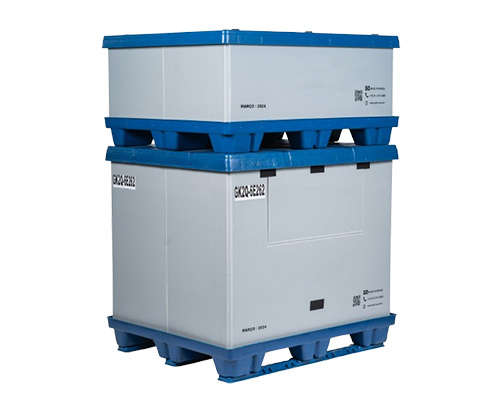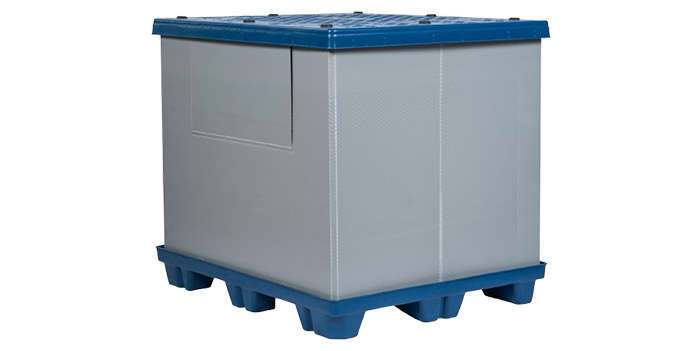
Benefits of the Container Pallet
Containers are practical and efficient solutions for transporting and storing goods.
Container pallets stand out for their robustness and versatility, guaranteeing safe cargo handling. Their design allows for safe stacking, space optimization, and logistics cost reduction.
Plastic containers with lids offer protection against impurities while maintaining the integrity of stored products.
Models such as the Packtainer and Big Pack are highly resistant and can withstand different temperature conditions.
Another advantage is the possibility of customization according to the specific needs of each client.
The use of materials such as HDPE guarantees durability and sustainability, as they are recyclable. Finally, their lightness and easy maintenance make these containers ideal for various sectors.
Additional Information
The containers are manufactured using modern processes such as thermoforming and extrusion, providing high resistance.
The container pallet is designed for entry from all four sides, making it easier to handle with forklifts and pallet trucks. Models such as Big Pack and Packtainer have drainage holes, preventing water from accumulating and keeping the cargo protected at all times.
The plastic container with lid offers extra security against contamination and loss during transportation. The dimensions vary depending on the model, allowing it to be adapted to different logistical needs.
These products can withstand extreme temperatures of down to -35ºC without compromising their structural integrity. With a fully nestable design, the containers facilitate efficient storage when not in use.
Companies looking to optimize space and reduce logistics costs find these containers an excellent solution.


Containers - Technical Specifications
| PALLETS | COVER | HOSES | ACCESSORIES | |||||||||
|---|---|---|---|---|---|---|---|---|---|---|---|---|
| MODEL | INTERNAL DIMENSIONS | EXTERNAL DIMENSIONS | SPACE BETWEEN LEGS | WEIGHT | ENTRY | DYNAMIC LOAD | INTERNAL DIMENSIONS | EXTERNAL DIMENSIONS | WEIGHT | MATERIAL | BELTS | CLIP |
| BIGPACK EURO | 745 x 1,150 mm | 815 x 1,230 x 160 mm | 205 mm (815) 290 mm (1,230) |
6 Kg | On all 4 sides | 1,000 Kg | 740 x 1,140 mm | 800 X 1,230 X 65 mm | 5 Kg | Alveoplast | - | - |
| BIGPACK PBR | 990 x 1,190 mm | 1.015 x 1.220 x 150 mm | 240 mm ( 1,000 ) 240 mm ( 1,200 ) |
10.5 kg | On all 4 sides | 1,000 Kg | 1,000 x 1,220 mm | 1,020 x 1,240 mm | 8 Kg | Alveoplast | For locking | Runner with 1.20 m |
| PACKTAINER | 990 x 1,190 mm | 1,000 x 1,200x 150 mm | 260mm ( 1.000 ) 265mm ( 1.200 ) |
7 Kg | On all 4 sides | 500 Kg | 990 x 1,190 mm | 1,000 x 1,200x 150 mm | 7 Kg | Alveoplast | For locking | - |
| PK 1012 | 990 x 1,190 mm | 1,000 x 1,200x 150 mm | 260mm ( 1.000 ) 265mm ( 1.200 ) |
7 Kg | On all 4 sides | 500 Kg | 990 x 1,190 mm | 1,000 x 1,200x 150 mm | 7 Kg | Alveoplast | For locking | - |
| PK 1214 | 1,130 x 1,390 mm | 1,200 x 1,465 x 155 mm | 235 mm (1,200) 255 mm (1,465) |
12 Kg | On all 4 sides | 500 Kg | 1,130 x 1,390 mm | 1,200 x 1,465 x 60 mm | 12 Kg | Alveoplast | For locking | - |
| PK 1317 | 1,240 x 1,645 mm | 1,300 x 1,700 x 155 mm | "345 mm (1,300) 540 mm (1,700) |
15 Kg | On all 4 sides | 500 Kg | 1,240 x 1,645 mm | 1,300 x 1,700 x 80 mm | 12 Kg | Alveoplast | For locking | - |
Frequently Asked Questions about Containers
The most suitable materials for containers depend on the type of cargo and storage conditions.
HDPE is widely used because of its high mechanical strength and long durability. This material can withstand temperature variations and impacts, guaranteeing safe transportation.
Models such as the pallet container and the plastic container with lid use HDPE to ensure additional protection.
Containers made from this material are washable and recyclable, contributing to sustainability. Its lightness makes it easy to handle, reducing operational efforts.
Opting for a stackable HDPE container provides greater logistical efficiency and durability.
The terms "container" and "container" are often used synonymously, but they differ. "Container" is a term of English origin, widely adopted in international trade to describe large storage and transportation structures.
"Container" is the Portuguese version, used mainly in Portugal and some specific segments in Brazil. Both refer to containers designed to store and transport goods safely.
Models such as Big Pack and Packtainer belong to the category of stackable logistics containers. Regardless of the term used, the important thing is to choose the right option for each application.
A pallet container is a type of container designed for storing and transporting cargo safely and efficiently. It combines the structure of a pallet with sturdy walls to form a robust containment system.
Models such as Packtainer and Big Pack are examples of pallet containers used in industries and logistics. This equipment is made from HDPE, guaranteeing durability and resistance to impacts.
They also allow safe stacking, optimizing space in warehouses and during transport.
With optional lids, they provide additional protection against dust and moisture. Companies in need of intelligent logistics solutions find these containers an efficient alternative.
The plastic container with lid offers extra security when storing and transporting goods.
It protects products from dust, humidity and external impacts, guaranteeing total integrity. Models such as the Big Pack have snap-on lids that prevent shifting during movement.
These containers are light and easy to clean, making maintenance simple. Made from HDPE, they are highly durable and resistant to extreme temperatures.
Another advantage is the possibility of customization according to customer needs. With precise fittings, they allow for safe stacking, optimizing space in warehouses.
Stackable containers are ideal for storing various types of materials safely.
They are widely used for packaging chemical, pharmaceutical and food products, guaranteeing protection against contamination. The automotive and logistics sectors also use containers to store parts and components.
Models such as Packtainer and Big Pack allow for efficient organization in warehouses and distribution centers.
The plastic container with lid protects sensitive cargo from moisture and dust. This type supports safe stacking, maximizing space without compromising the integrity of the cargo.
Choosing the ideal container depends on factors such as the type of cargo, weight and storage conditions. For heavy loads, models such as Big Pack offer high capacity and security.
If you need extra protection, a plastic container with a lid is an excellent option. Companies that need to optimize space can opt for stackable containers such as Packtainer.
The material is also an important criterion: HDPE guarantees strength and durability. Taking into account the temperature and storage environment is also essential.
Consult PLM, which will help you choose the best container for each application.
Stackable containers offer better use of space in warehouses, reducing operating costs. With a precise fitting system, they allow safe stacking, avoiding accidents and optimizing logistics.
The use of these containers facilitates the movement of products, making internal transportation more efficient. In addition, their structural strength ensures that they can withstand heavy loads without compromising safety.
Models such as the Big Pack and the Packtainer have protective lids, guaranteeing the integrity of the goods. Made from recyclable materials, these containers also contribute to sustainability.
Another positive point is the possibility of customization, adapting to the specific needs of each sector. They are therefore a strategic choice for companies looking for modern and efficient solutions.
Container manufacturing follows strict technical standards to ensure safety and quality.
In Brazil, the main reference is ABNT NBR 16242, which establishes requirements for plastic pallets used in the storage and transportation of cargo. International standards, such as ISO 1496, define structural standards for containers used in intermodal transportation.
Certain safety regulations ensure that models such as the pallet container and the plastic container with lid are resistant to impacts and climatic variations. Companies in the sector also carry out internal tests to ensure product quality.
Materials such as HDPE guarantee high durability, meeting the required standards. Therefore, following these standards is essential to ensure the safety of logistics operations.
Yes, several container models are suitable for international transportation. The Big Pack and the Packtainer, for example, have a reinforced structure that allows cargo to be moved safely.
Plastic containers with lids protect products from moisture and impacts during long journeys. The specifications follow international standards that guarantee compatibility with different modes, such as sea, rail and road.
The pallet container makes it easier to handle with forklifts and pallet trucks, speeding up logistics processes. Some versions have drainage holes to prevent water from accumulating during transportation.
Their lightness combined with resistance makes these containers an ideal option for exporting a variety of products. They are therefore widely used by industries that need safe and efficient transportation.
To ensure the durability of containers, it is essential to clean them regularly. The use of water and neutral detergents helps to remove dirt and prevent residue build-up.
Plastic containers with lids should be stored in dry, well-ventilated areas to avoid structural damage. Avoid overloading stackable models to ensure safe storage.
Transportation must also be carried out carefully to avoid excessive impact. Regular inspections help to identify wear and tear and the need to replace accessories.
The correct distribution of weight inside the Big Pack and Packtainer also influences conservation. By following these practices, the useful life of the containers will be extended, guaranteeing better value for money.
The Big Pack and the Packtainer are containers designed to optimize storage and transport logistics.
The Big Pack is ideal for heavy loads and has a robust structure that guarantees safe stacking. The Packtainer is a lighter and more flexible option, suitable for moderate loads and practical storage.
Both have docking systems that make stacking easier and optimize space. The pallet container used in both models improves load stability.
The lid on both models protects the products from external factors such as moisture and dust.
Their ergonomic design makes them easy to move around different sectors. So the choice between Big Pack and Packtainer depends on the specific needs of each operation.
There are different types of Big Pack and Packtainer to meet market demands. The models vary in size, load capacity and materials used in manufacture.
The Big Pack Euro, for example, has a lightweight structure but is highly resistant to loads of up to 1,000 kg. The PK 1012 Packtainer is ideal for operations that require lighter containers without compromising safety.
There are also versions with different spacing between the legs, making it easier to fit into pallet racks.
Some models have advanced locking systems for greater cargo security. The variety allows each customer to choose the best solution for their logistics. In this way, companies from different segments can optimize their processes.
The correct disposal of containers is fundamental to reducing environmental impacts. As they are made of recyclable plastic, the ideal is to send them to companies that specialize in recycling.
Some industries have collection programs, ensuring that the material can be reused. The pallet container can also be reused in different applications, extending its useful life.
Avoid disposing of these products in landfills, as they can be reused in new production processes.
Conscientious disposal contributes to environmental preservation. Reverse logistics thus becomes a sustainable differentiator for companies and consumers.
